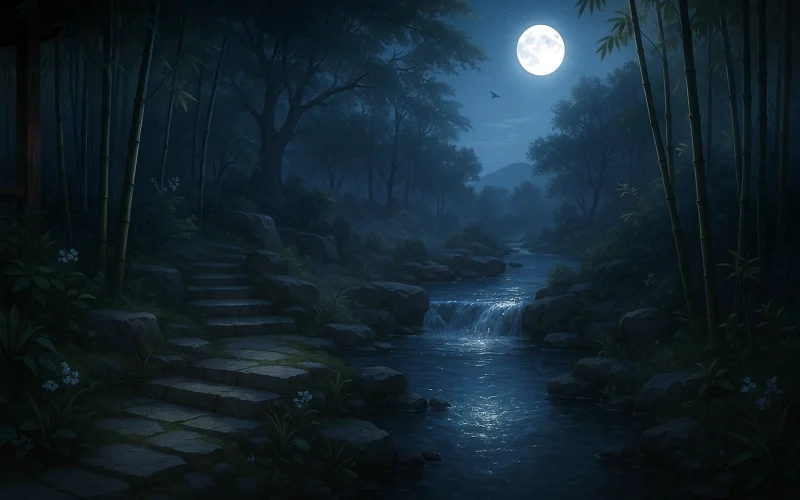Long rains just cease—air fresh and wide,
Alone I trace the Yu Creek's side.
My staff probes the wild spring’s bed,
My belt girds young bamboos’ head.
What need for deep contemplation?
Solitude is my aspiration.
Blessed respite from worldly fuss—
My chant cools the sultry dusk.
Original Poem
「夏初雨后寻愚溪」
柳宗元
悠悠雨初霁,独绕清溪曲。
引杖试荒泉,解带围新竹。
沉吟亦何事,寂寞固所欲。
幸此息营营,啸歌静炎燠。
Interpretation
Composed during Liu Zongyuan's Yongzhou exile (805-815 CE), this poem marks a philosophical turning point in his banishment oeuvre. Having christened the stream "Fool's" (愚溪) as both self-mockery and social critique, Liu here transforms a post-rain excursion into a manifesto of anti-ambition—where voluntary simplicity becomes the ultimate sophistication. The work's unusual serenity among his generally acerbic exile poems reveals hard-won reconciliation between political failure and spiritual freedom.
First Couplet: "悠悠雨初霁,独绕清溪曲。"
Yōuyōu yǔ chū jì, dú rào qīng xī qū.
Endless rains finally clear—
Alone, I trace the stream's cursive path.
The opening couplet establishes hydrological harmony: "endless rains" (悠悠雨) mirror the prolonged exile, while the stream's "cursive path" (曲) reflects both its physical meandering and the poet's non-linear spiritual journey. The act of solitary tracing becomes a form of calligraphic communion with nature.
Second Couplet: "引杖试荒泉,解带围新竹。"
Yǐn zhàng shì huāng quán, jiě dài wéi xīn zhú.
My staff probes wild springs' depth—
Unbelted, I cradle bent bamboo.
These practical gestures transcend utility: "probing springs" (试荒泉) symbolizes philosophical inquiry into life's sources, while "cradling bamboo" (围新竹) with his official belt (带) repurposes bureaucratic regalia as a horticultural splint—an act of quiet institutional subversion.
Third Couplet: "沉吟亦何事,寂寞固所欲。"
Chén yín yì hé shì, jìmò gù suǒ yù.
What use now for brooding?
This solitude is chosen.
The rhetorical question dismisses past political anxieties, while "chosen solitude" (固所欲) asserts agency over exile's circumstances. The couplet's abrupt syntax mirrors the decisiveness of this intellectual pivot.
Fourth Couplet: "幸此息营营,啸歌静炎燠。"
Xìng cǐ xī yíng yíng, xiào gē jìng yán yù.
Blessed respite from ant-like toil—
My song stills summer's fever.
The closing juxtaposes "ant-like toil" (营营), a Zhuangzian metaphor for bureaucratic striving, with the poet's transcendent "song" that paradoxically brings coolness (静炎燠). This sonic alchemy—where voice modulates climate—epitomizes Liu's newfound belief in art's power to reshape reality.
Holistic Appreciation
This poem exemplifies the tradition of "expressing emotions through landscape," yet it differs from Liu Zongyuan's earlier exile poetry marked by melancholy and indignation. Here, the poet reveals a more transcendent and carefree state of mind. With concise language, he captures the beauty of a riverside morning after rain, weaving reflections on reality and life's insights into his journey along the stream.
The poem progresses from scene to emotion, from action to introspection. Concrete acts like "wandering alone," "leaning on a staff," and "loosening my robe" illustrate his effort to rebuild self-worth through nature. The line "What need is there for contemplation? Solitude has always been my desire" reflects his release from past political entanglements. The closing "My song cools the summer heat" elevates the poem to a spiritual realm—one of actively embracing reality and transcending adversity.
This work showcases Liu Zongyuan's inner transformation: from passively enduring exile to actively seeking inner freedom and equilibrium. It is not merely a depiction of nature but a philosophical epiphany and an elevation of life attitude.
Artistic Merits
- Fusion of Scene and Emotion, Quietude in Motion
The poet's footsteps drive the rhythm, with scenes unfolding as he moves and emotions shifting with the landscape. "Testing the wild spring" and "circling new bamboos" are dynamic images, yet they create an overall serenity, achieving an artistic effect of "finding stillness within motion." - Philosophy Embodied in Imagery, Rich Symbolism
The spring symbolizes clarity of thought and depth of inquiry; the bamboo represents resilience or new growth. Liu subtly merges philosophical reflection with natural imagery, yielding profound yet understated meaning. - Unadorned Language, Lucid Atmosphere
The poem's diction is simple and unembellished, yet it conveys depth through plainness. Without explicit declarations of ideals, it reveals layered insights into fate, aspiration, and human existence, embodying a "sparse elegance that surpasses ornate beauty."
Insights
This is a poem about "inner peace." It teaches us that the true way out of adversity lies not in external change but in internal adjustment. By the Fool's Stream, Liu Zongyuan engaged in dialogue with nature through poetry, emerging from life's shadows to find spiritual tranquility and composure.
In today's fast-paced, anxiety-ridden world, this poem holds particular relevance. It reminds us to step back from chaos, seek a "stream for the soul," temper conviction in solitude, and preserve passion in stillness. So long as we harbor a "Fool's Stream" within, we can "sing to cool life's heat"—transcending environmental constraints to live with serenity and wisdom.
About the Poet

Liu Zongyuan (柳宗元, 773 - 819), a native of Yuncheng in Shanxi province, was a pioneering advocate of the Classical Prose Movement during China's Tang Dynasty. Awarded the prestigious jinshi degree in 793 during the Zhenyuan era, this distinguished scholar-official revolutionized Chinese literature with his groundbreaking essays. His prose works, remarkable for their incisive vigor and crystalline purity, established the canonical model for landscape travel writing that would influence generations. As a poet, Liu mastered a distinctive style of luminous clarity and solitary grandeur, securing his place among the legendary "Eight Great Masters of Tang-Song Prose" - an honor reflecting his enduring impact on Chinese literary history.












